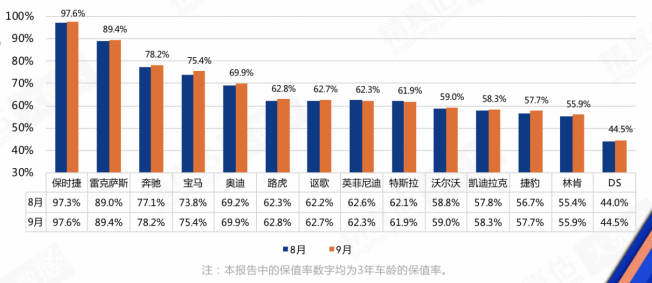In September, the price of each level of hedging rate continued to rise. Previously, the trend of rising prices of used cars has been going on for several months, and insufficient supply has become the main reason for this round of price increases. In the small car segment, the price of second-hand cars has risen higher than the overall price, showing a strong rebound momentum, reflecting the seriousness of the "insufficient product supply". Toyota Vios and Zhixuan became popular used car models in September.

Luxury brand second-hand car prices generally rose in September
Luxury brands generally increase prices. The price of used cars of Mercedes-Benz, BMW and Audi have increased significantly. Infiniti and Tesla's retention rate declined. BMW recalled a large number of imported models in September. In terms of production time, these recalled vehicles are generally more than 5 years old. In September, most luxury brand second-hand cars maintained a price increase trend. Among them, BBA was the absolute main force in the market, and the price increase was greater than other brands. This includes factors leading to the increase in the guide price of new cars, such as the Audi Q3 car series. Dealers in some regions of the BBA have launched the activity of "distributing fares to buy back second-hand cars". Although the proportion is relatively small, it has an impact on the expectations of second-hand car prices.The Honda brand has risen and fallen. The price of new Honda UR-V, a mid-size SUV, has been significantly reduced, and the market is cold. The Hyundai brand has a relatively complete product portfolio for cars and SUVs and a relatively stable price system for new cars. After actively adjusting production capacity and shrinking channels, the balance of supply and demand has basically been achieved. The quality, reliability and fuel consumption of used cars are also at the upstream level of the industry. Hyundai Skutu MPV was launched at the end of September, with a long pre-heating period, and the overall attention of Hyundai brand is in a relatively high position.
The value retention rate of American brands has rebounded. The circulation of used cars is not large. With the high-profile launch of Ford Mustang Mach-E, not only is the electric vehicle market ushering in new players, even in the field of fuel vehicles and second-hand vehicles, consumers have regained confidence. Wrangler models equipped with hybrid systems under the JEEP brand are on the market, and energy efficiency may be greatly improved, thereby gradually changing the old brand image.
The own brand has changed slightly. The dual-brand strategy under independent manufacturers has achieved results. MG and Roewe have both entered the top 15 independent brands and have increased month by month. Under the background of the current stock market, accurate positioning is easier for consumers to accept and recognize. This strategy is helping many car companies to quickly devour the market.
The value retention rate of new energy vehicles has stabilized. The Mercedes-Benz brand announced during the Munich Auto Show that it will no longer develop new PHEV systems, which means that plug-in hybrid models will only be slightly modified in the future without substantial changes. In the future, the share of Mercedes-Benz pure electric models in the new car market will gradually expand. In the Chinese market where multiple technological routes are parallel, abandoning PHEV is equivalent to giving up one of the tracks, which may also prove that the current hybrid technology of independent brands has advanced by leaps and bounds and has a clear advantage. In terms of pure electric vehicles, although second-hand vehicles are still dominated by independent brands, the “new joint venture” model is becoming a trend. Electric vehicles are expected to completely change consumers' perception of the value of electric vehicles.
The overall value retention rate of new energy vehicles did not change much in September. In the key models, Hongguang MINI EV rushed to the first place, with a one-year value retention rate of 84.7%; Han DM and Han EV also rose in rankings; as a new brand of R car ER6, the value retention rate reached 72.4% in one year.
















 RCCN WeChat QrCode
RCCN WeChat QrCode Mobile WebSite
Mobile WebSite